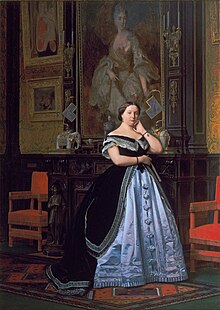
Charlotte de Rothschild
Charlotte de Rothschild | |
|---|---|
 1866 Portrait of the Baroness Charlotte de Rothschild by Jean-Léon Gérôme (Musée d'Orsay, Paris) | |
| Born | 6 May 1825 Paris, France |
| Died | 20 July 1899 (aged 74) Paris, France |
| Spouse | |
| Children | Nathalie de Rothschild (b. 1843) Nathan James Edouard de Rothschild (b. 1844) Mayer Albert de Rothschild (b. 1846) Arthur de Rothschild (b. 1851) |
| Parent(s) | James Mayer Rothschild and Betty von Rothschild |
Baroness Charlotte de Rothschild (6 May 1825 – 20 July 1899) was a French socialite, painter, and a member of the prominent Rothschild banking family of France.

Early years
She was born in Paris, the daughter of Betty von Rothschild (1805–1886) and James Mayer de Rothschild (1792–1868).[1] Charlotte de Rothschild was raised by very wealthy parents who were at the center of Parisian culture. They patronized a number of major figures in the arts community including Gioacchino Rossini, Frédéric Chopin, Honoré de Balzac, Eugène Delacroix, and Heinrich Heine. Chopin had become Charlotte's piano teacher in 1841, and as a tacit acknowledgment of the many years of support extended by Baron James and his wife Betty, dedicated to her an autograph of his so-called Farewell-Waltz in A-flat major, Op. 69 No.1,[2] (almost certainly as an 1843 wedding present) his celebrated Ballade No. 4 in F minor, Op. 52, and four years later another work, his Waltz in C-sharp minor, Op. 64, No. 2.

Married life
In 1842, Charlotte married her English-born cousin Nathaniel de Rothschild (1812–1870) and in 1850 they moved to Paris, where he went to work at her father's bank, de Rothschild Frères. They were the parents of:

- Nathalie de Rothschild (1843–1843)
- Nathan James Edouard de Rothschild (1844–1881)
- Mayer Albert de Rothschild (1846–1850)
- Arthur de Rothschild (1851–1903)
While Charlotte de Rothschild and her husband would always live in Paris, in 1853 they purchased the Château Brane-Mouton vineyard that they renamed Château Mouton Rothschild. In 1878, Charlotte bought the Abbaye des Vaux de Cernay in Cernay-la-Ville in the Vallée de Chevreuse, at the time only a ruins of a Cistercian abbey built in 1118. She undertook extensive restoration work and new construction to make the lakeside property into a country home. The property remained in family hands until 1945 when it was by sold by her grandson Henri James de Rothschild to aircraft manufacturer Félix Amiot.

Artist

Like her father, Charlotte de Rothschild was a collector of art and grew up around her artistic friends. As an adult, Charlotte would count amongst her friends the likes of Jean-Baptiste-Camille Corot, Henri Rousseau, and Édouard Manet. Her art purchases included works by Henri Fantin-Latour, Louis-Léopold Boilly, Anthony van Dyck plus a number by Rococo painters Jean-Baptiste-Siméon Chardin, Giovanni Battista Tiepolo and François Boucher. However, Charlotte de Rothschild's interest in art went beyond collecting. Talented in her own right, she studied with Nélie Jacquemart (1841–1912) and would earn respect for her landscape paintings, watercolors and engravings, enough so that she is recognized in the Benezit Dictionary of Artists. She exhibited in 1872 at the Paris Salon as well as at an 1879 exhibition in London, and from 1879 showed work at the annual salon of the Société des aquarellistes français.[3] Although a minor artist, her work has been on display at the Musée du Luxembourg in Paris and other museums around France. Her illuminated Haggadah of Pesach is in the Braginsky Collection.[4]

Charlotte de Rothschild's interest extended to music, entertaining musician friends such as Georges Bizet and Camille Saint-Saëns. Charlotte de Rothschild's lifetime of involvement in art and music would greatly influence her offspring, producing writers, actors and playwrights.

Later years
Tragedy struck her family in 1881 when she lost her eldest surviving child, thirty-seven-year-old James-Edouard.[citation needed] An attorney in the Rothschild bank in Paris, James-Edouard de Rothschild had served in the Garde Mobile during the Franco-Prussian War and suffered from a number of illnesses, including depression that led to his suicide.

See also
References
- ^ Harry W. Paul (2005). Collecting Chardins: Charlotte and Henri de Rothschild Archived 2012-03-07 at the Wayback Machine. The Rothschild Archive: Review of the Year April 2004 – March 2005. ISSN 1748-9148 (print), 1748-9156 (web). pp. 21–26. Accessed September 2013.
- ^ Chopin, Frédéric (2007). Grabowski, Christophe; Rink, John; Samson, Jim; Eigeldinger, Jean-Jacques (eds.). The Complete Chopin - A New Critical Edition (in English and German). Vol. Waltzes. London, Frankfurt, Leipzig, New York: Edition Peters. pp. 136f. ISMN 9790577085579. OCLC 1328129061.
- ^ [s.n.] (1879). Société d'aquarellistes français: Première exposition; rue Laffitte, 16: Catalogue (in French). Paris: Imprimerie de D. Jouaust.
- ^ Adding the Personal to the Purely Sacred, Edward Rothstein, June 25, 2010, New York Times.
See what we do next...
OR
By submitting your email or phone number, you're giving mschf permission to send you email and/or recurring marketing texts. Data rates may apply. Text stop to cancel, help for help.
Success: You're subscribed now !
